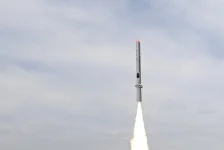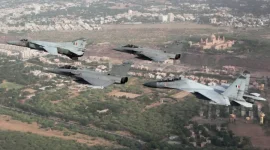- Views: 2K
- Replies: 12
Reports indicate that the Hellenic Air Force (HAF), the aerial warfare branch of Greece, is expressing significant interest in acquiring India's Rudram series of anti-radiation missiles.
These advanced missiles, the Rudram-1 and Rudram-2, are developed by India's Defence Research and Development Organisation (DRDO) and are designed to be launched from aircraft.
Their primary purpose is to neutralise enemy air defence systems, a capability known as Suppression of Enemy Air Defences (SEAD) or Destruction of Enemy Air Defences (DEAD), by targeting crucial assets like radar installations, communication hubs, and fortified bunkers.
This development comes as the Indian Air Force (IAF) is also making progress in equipping its own Rafale and Tejas Mk1A fighter jets with the Rudram-1, bolstering India's position as a potential global provider of sophisticated SEAD technology.
This interest from Greece arises at a time when some of its European NATO allies, such as France and Germany, have identified shortcomings in their specialised anti-radar weaponry.
These nations currently depend largely on the American-manufactured AGM-88 HARM missile or are anticipating the future availability of the MBDA RJ10 missile, which is not projected to be operational with the Rafale F5 fighter jet variant until approximately 2035.
Greece, an important member of the NATO alliance, has incorporated 24 Rafale fighter jets into its air force as part of a significant modernisation effort aimed at addressing regional security challenges, including tensions in the Eastern Mediterranean.
For critical missions to suppress enemy air defences, the Hellenic Air Force presently uses AGM-88 HARM missiles sourced from the United States.
However, India's Rudram-1 and Rudram-2 missiles are emerging as a strong potential alternative. Sources suggest that HAF officials have initiated discussions with Indian defence representatives to explore the possibility of equipping their Rafale aircraft with these Indian missiles
These discussions are notably bolstered by a recent technology transfer agreement reportedly signed on April 28, 2025, between India and Dassault Aviation, the manufacturer of the Rafale, which facilitates the integration of Indian-developed weapons onto the French-made jets.
The Hellenic Air Force's growing interest is reportedly driven by the advanced capabilities of the Rudram missile family and Greece's strategic requirement for a strong capacity to neutralise hostile air defences.
France, a primary supplier of Rafale jets, has not had a dedicated anti-radar missile since retiring its AS.37 Martel in the late 1990s.
While the new MBDA RJ10 missile, a component of the Franco-British Future Cruise/Anti-Ship Weapon (FC/ASW) initiative, is intended for these SEAD tasks, it is not expected to be ready for deployment on the Rafale F5 aircraft until 2035, according to a Defense News report from March 17, 2025.
In the meantime, Germany and other NATO countries largely rely on different versions of the AGM-88 HARM missile. While these missiles are effective, they are also expensive and may offer less flexibility compared to the Rudram series, which is designed to be compatible with multiple aircraft types.
The Rudram-1 boasts an operational range of 100 to 250 kilometres, while the Rudram-2 can reach targets up to 300 kilometres away.
The fact that these missiles are produced domestically in India by companies such as Bharat Dynamics Limited (BDL), Bharat Electronics Limited (BEL), and Adani Defence & Aerospace further positions them as an appealing and economically viable choice for Greece.
The broader European landscape for SEAD capabilities is currently facing notable challenges. This concern was highlighted by French Air Force Lt. Col. Adrien Gorremans, who reportedly stressed at a Paris forum earlier in 2025 that SEAD should be considered a "number one priority."
Since the retirement of its Martel anti-radiation missile, France's Rafale aircraft have had to rely on SCALP-EG cruise missiles for some related tasks, though these are not specifically designed or optimal for SEAD missions.
The upcoming MBDA RJ10, a high-supersonic missile powered by a ramjet engine, is intended to fill this capability gap, but its projected operational readiness with the Rafale F5 in 2035 means a potential vulnerability window of nearly a decade.
Countries like Germany, Poland, and other NATO members currently utilize the AGM-88 HARM, which has a significant per-unit cost estimated between $1 million and $2 million, potentially restricting how many can be acquired.
Greece, which also operates these HARM missiles, is actively looking for alternatives to lessen its dependence on American suppliers and to better align its armament with its Rafale-focused air power strategy.
The Indian Rudram missile series presents a financially attractive solution, with an estimated cost per unit of ₹10 to ₹15 crore (approximately $1.2 million to $1.8 million USD, based on the reported IAF deal for 1,000 units at ₹14,000 crore).
Furthermore, Rudram's proven compatibility with the Rafale jet, demonstrated by India's own integration initiatives, and its domestic production by Indian firms like BDL, BEL, and Adani Defence, offer a more reliable supply chain compared to the HARM, which relies on U.S. manufacturers.
Looking towards the future, sustained interest from the Hellenic Air Force could pave the way for a formal procurement proposal by 2026, particularly if India continues to successfully integrate the missiles.
The DRDO is also reportedly developing more advanced versions, including the Rudram-3 with an anticipated range of 550 kilometres, and a ground-launched variant. These future developments are likely to increase the attractiveness of the Rudram series to other NATO countries as well.
India's broader strategy for defence exports, supported by domestic manufacturing and potential technology transfer agreements, positions the Rudram missile family as a significant new entrant with the potential to reshape the global market for SEAD technology.


